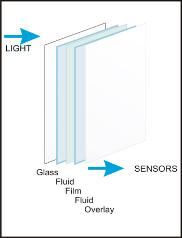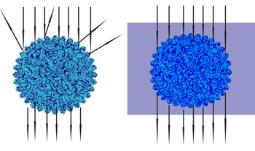Origins in Fluid Immersion
Microscopy
|
|
In Microscopy, Fluid immersion increases the resolution of the lens and extends its resolution and
magnification well beyond what is possible with dry microscopy. A Similar process occurs with fluid
scanning. (The numerical Aperture of the lens is proportional to its numerical aperture which in turn
is proportional to the refractive index of the fluid). Similarly,
Nikon microscopy website has an excellent write up of oil immersion microscopy. See Link
http://www.microscopyu.com/tutorials/java/objectives/immersion/
|
|
|
In Fluid Immersion Scanning, the film is immersed in fluid during the scan. This is accomplished by
placing fluid between glass an film and film and an optically clear overlay, as illustrated in the image
(1) to the right, Ideally the fluid and the film backing have the same index of refraction or the closest
the better. The index of refraction of LUMINA is close to that of the film backing.
|
|
Better Image Quality in Fluid
Immersion Scanning
|
|
- When the source light strikes the dry grain, some of it travels through and some is lost to reflection.
When light strikes film immersed in fluid, the light can travel through the grain without loss to
reflection. (Fig. 2)
- Reducing losses through reflection makes the image appear more brilliant and with greater color
saturation.
- Grain rich areas of the film block the passage of light. When some of the light is lost through
reflection, there is less light available to illuminate the shadows and detail in the shadows are lost.
Because there is more transmission integrity with fluid scanning, there is better definition of the
shadow areas, and greater dynamic range.
|
|
Elimination of Pepper Grain
|
|
- Because losses through reflectivity at the grain are minimized with fluid scanning, less light is
scattered as it hits the grain,-which results in greater resolution. Reflectivity and light-scattering also
have the effect of emphasizing the grain, making it appear bigger and coarser than it really is.
- Cutting reflectivity cuts pepper grain. "Pepper grain" drives photographers to distraction but that
only occurs to photographers that use high quality film scanners like the NIKON 8000 and the
Imacon (prior to the latest model) which use a highly collimated light source. That collimated light
source, increases the reflectivity of the grain and causes 'pepper grain'. The pity is that scanners
that use a collimated light source potentially produce sharper scans. Because fluid immersion
undoes the negative effect of a collimated light, that potential is fully achieved if such scanners are
used as fluid scanners.
- Flatbed scanners are seldom blamed with pepper grain, because only a very few of those can pick
up grain detail. Drum scanners, in spite of their high resolution, never get blamed for "pepper grain"
either because all drum scanners are fluid scanners.
|
|
Elimination / reduction of Dust
& Scratches
|
|
Fluid scanning has a similar effect on dust and scratches but while digital ICE generally degrades
the image, fluid scanning upgrades the image. The extra time sp0ent on scanning with digital ICE is
overcompensated by fluid scanning, It takes less time to fluid mount than to scan with digital ICE.
|
|
Newton Rings
Good bye to the glass holder
|
|
- Newton Rings are caused by reflections between two surfaces when one of the surfaces is
separated from the other at a slight angle. Along the horizontal axis, of the projection of a sine wave,
the reflections from the surfaces interact and either knock each other out or help each other.
- The the result is a series of concentric rings that alternate between dark and light. Newton rings are
encountered in old fashioned devices such as the glass holder for the NIKON and a diffuser device
that was sold to Minolta scanner users. People use these devices hoping to restrain film curvature
and achieve a flat film plane, although that only succeeds when the curvature is down on the glass.
With fluid scanning a perfectly flat film plane is a given, and without degrading the image as the
glass holders do.
- Fluid scanning attains film flatness utilizing the surface tension of the fluid to temporarily 'glue' the
film to the glass. The detrimental effects these old devices make them obsolete.
|
|
Newton Rings
Goodbye to Anti-Newton Glass
|
|
- Since with Fluid Scanning newton rings are a thing of the past, AN glass has outlived its usefulness.
AN glass is glass which has corrugations on the surface to break the Newton Rings but is
detrimental the image. You would not put AN glass in front of your camera lens.
- The improvement in image quality between a fluid scan and a glass holder with AN glass is
significant. The ScanScience System brings you refraction-free Fluid scanning to film scanners at a
fraction of the cost of glass holders, and AN glass
|
|
Limitations of Dry Processes:
Scanning , Enlarging, and
Projection
|
|
All these processes are similarly impaired. The degradation of image quality due to the reflections
and scattering at the film grain are shared equally by all techniques. All these practices are similarly
impaired. The degradation of image quality due to the reflections and scattering at the film grain are
shared equally by all techniques.
|
|
Fluid Scanning techniques for
film and flatbed scanners by
ScanScience well established
for Drum Scanners
|
|
- First used in drum scanners and now with the advent of ScanScience it is universally used on all
scanners.
- Because drum scanners are fluid scanners by definition, their uniquely saturated and sharp quality
and smoothness made it the choice of connoisseurs.
- With the advent of ScanScience, all other scanners can benefit in the same measure from fluid
immersion scanning. Significantly, users that have access to a drum scanner are finding that fluid
scans with their NIKON, IMACON and EPSON scanners rival drum scans.
|
|
Time Spent:
Digital ICE vs
Fluid Scanning
|
|
Fluid scanning with ScanScience's LUMINA Optical Super Fluid is easy and quick, it takes very
little time and requires no post operative cleaning and drudgery. Compared to digital ICE it saves
time: You can assemble a wet mount faster than you can scan with digital ICE and it upgrades the
image instead of degrading it like digital ICE.
|
|









